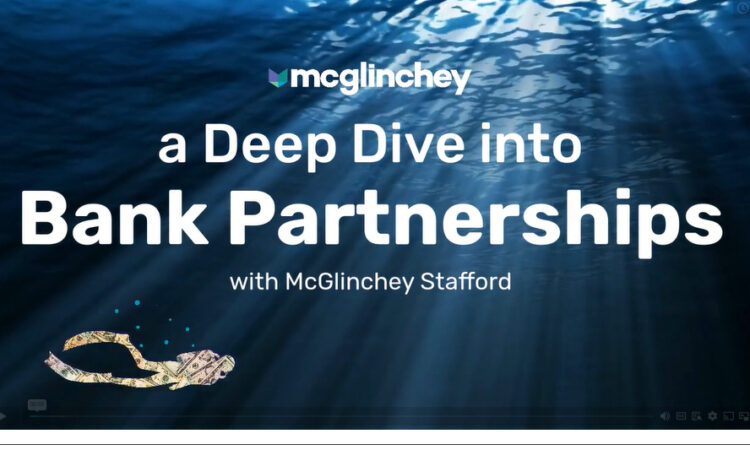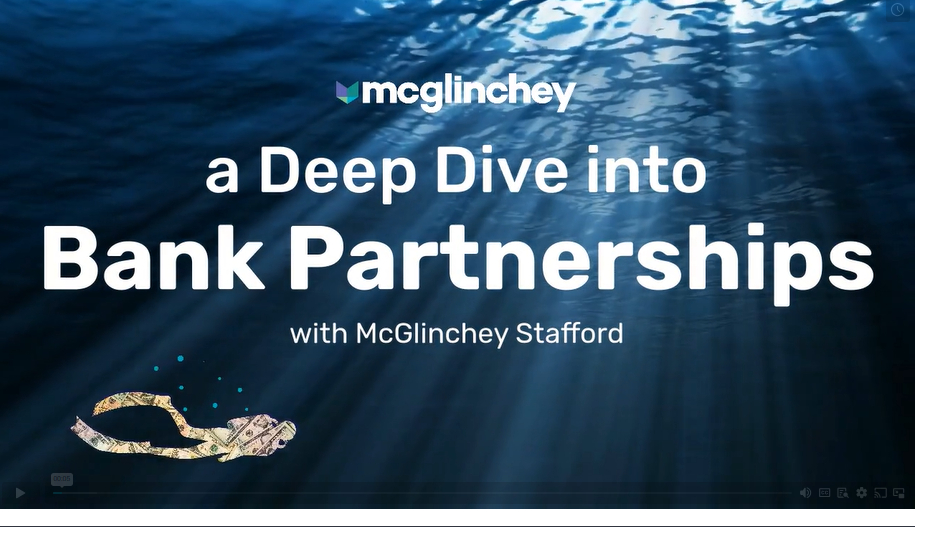
Bank partnership programs have grown exponentially in recent
years as a collaborative framework for banks and non-depository
institutions to offer innovative and unique products to their
customers.
Navigating the modern financial services regulatory ecosystem
remains a challenge. Banks and their partners must closely assess
everything from program requirements and contractual structures to
compliance requirements, licensing hurdles, true lender concerns,
and other issues at the state, federal, and even international
level.
Over the coming months, McGlinchey attorneys from various
practice groups will dive into the world of bank partnerships and
explore this nuanced topic from every angle. From articles,
podcasts, and webinars on hot topics to a client-only, live CLE
session, the content will be geared towards busy schedules and
drilled down to the good stuff – what should the
financial services industry be thinking about with regard to bank
partnership programs?
In this introductory video, Members of our Financial Institutions Compliance Team,
Aaron Kouhoupt (Cleveland) and Robert
Savoie (Cleveland), will discuss this fascinating and
vibrant subject matter while giving you a breakdown of the content
you can expect in the coming weeks.
Robert Savoie: Thanks, Aaron. I’m Robert
Savoie. I’m the chair of McGlinchey’s FinTech practice. And
I think this deep dive is going to be really neat because
there’s a lot of ground to cover. If you think about the
context and ways in which depository institutions and
non-depository institutions partner and come together to form the
modern financial services ecosystem, it varies dramatically and
ranges from programs that are incredibly benign to programs where
there’s a lot more controversy. There’s a lot more
legislation and even litigation action that impacts those
programs.
I think we’ll see that certain types of programs can be more
focused on soft items, like Unfair Deceptive Acts or Practices
(UDAP) or customer service concerns about responsiveness, right?
Neobanks and payment programs are more about the programs
interacting with customers, and many of the substantive federal
laws that apply to the banks are passed along through the non-bank
entities via contract and vendor requirements, whereas consumer
lending programs have been subject to greater scrutiny because
federal agencies are focusing on enforcement against banks involved
in that and holding their feet to the fire on regulatory
compliance. Then, the state legislatures amend their laws to
capture these programs. It seems to be an acceleration of a trend
that we’ve seen for a number of years, expanding beyond the
long-standing concept of regulating the non-bank entity that
performs services for a bank.
If you think about the origin of that, with debt collection,
right? Or servicing activity, there have been debt collection,
licensing, and substantive regulations for decades and that’s
certainly not a new concept. What’s been really interesting
over the last few years is that there’s been a rise of
so-called true lender legislation, or some people call
it the predominant economic interest legislation, where the state
legislatures are seeking to restrict the products that the bank
offers via indirect regulation because they can’t regulate them
due to the impact of federal law via a direct regulation, and
instead of focusing on supervision and oversight of the activities
of the non-bank.
Then, add a little flavor of Depository Institutions
Deregulation and Monetary Control Act (DIDMCA) opt-outs that impact rate exportation
for state charter depository institutions, and you get a really
interesting maelstrom of wholly different activities and different
requirements that play in.
Aaron will run through the different types of programs. The
concerns that you have vary wildly based upon particular programs
and contractual structures in terms of whether a particular
requirement becomes a non-event because compliance is easy, or sort
of a program existential question around, what does this mean? And
what does it do for the future operation of the program?
Aaron Kouhoupt: Yeah, I think it’s going to
be fun over the next few weeks to talk about these different
programs and break it down into some relatively bite-size pieces of
where the issues will come in. You have licensing issues that are
primarily centered around the non-banks. You have program
arrangement and sort of compliance management and how the banks are
doing their vendor due diligence – to your point, how
they’re operating their compliance systems. Because I think
that the key that we’ll hear throughout all these programs and
all these partnerships and probably a theme that, if somebody
listens to all of these, you’re going to hear it every time, is
that the bank in the partnership is the entity that is doing
regulated activity. The non-bank is performing a function that is
sort of on behalf of those regulated entities, and they might have
their own requirements that kick in, but really, two distinct paths
that you’re taking there as far as what you’re regulated
under and why.
And I think that it can get really fun when you start to parse
through those, then you throw in the enjoyment of, you know, how
much you can interfere with the national bank and the difference
between national banks and state-chartered banks.
And to add a ton of flavor to all that, we’re really excited
that one of the webinars we’re going to do is going to be with
a partner at a law firm that is based out of London, and he’s
going to talk a little bit about how our structure is very
different than what you see, and some of the challenges that you
run into, when you’re not used to state banks and national
banks and federal state overlay, and just all of the little nuances
that come into play when you’re doing bank partner programs in
the U.S.
Robert Savoie: One of the other interesting
things I’ve always enjoyed, and I’d be remiss not to
mention it, is that my entire time at McGlinchey, I’ve had the
pleasure of working with senior partners that have worked on bank,
non-bank programs in the consumer credit space, since the early
1980s and watching the evolution of the regulation of those
programs over my career and learning about the regulation of that
prior to me even becoming a lawyer has been really fascinating to
see in terms of the shift and the change of the tenor of that
regulation, even though these programs and the interaction between
depository institutions and non-depository institutions and other
elements of the economy is sort of a long-standing thing. But the
ebb and flow of focus of different elements have been fascinating
to see where changes in politics and changes in things that are
going on in the economy more broadly sort of directly impact, you
know, the intensity and the frequency of regulation and space.
Aaron Kouhoupt: So, we are looking forward to
the next few weeks. I hope that everybody can join us for the
different programs that we’re going to do.
As with all deep dives, there will be a mix of webinars and
podcasts, some articles that will go out, and then we’ll end it
with a Continuing Legal Education (CLE) event that people can come
in, join, and earn continuing legal education credits. We look
forward to it. Thank you for joining me today, Robert. There will
be more to come.
The content of this article is intended to provide a general
guide to the subject matter. Specialist advice should be sought
about your specific circumstances.






